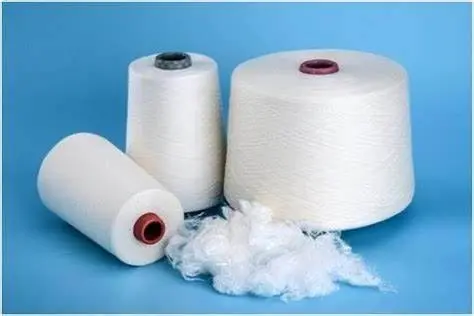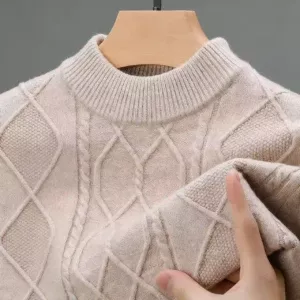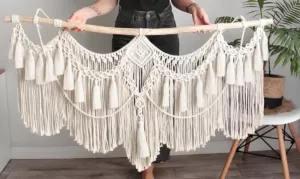About Polyester Yarn for Athletic Wear – When it comes to athletic wear, the fabric is not just a matter of fashion—it’s a vital component that can significantly affect an athlete’s performance. Quality fabric can mean the difference between comfort and chafing, endurance and exhaustion, triumph and defeat. Athletes require apparel that works with their bodies, adapting to movement and environmental conditions while allowing them to focus solely on their performance. This demands materials that are not only flexible and durable but also capable of regulating temperature, managing moisture, and maintaining comfort over extended periods of physical exertion.
Tracing the Trajectory of Polyester Yarn in Athletic Apparel
Polyester yarn has been a longstanding staple in the textile industry since its inception in the mid-20th century. Initially valued for its exceptional durability and ease of maintenance, polyester’s role in sportswear has evolved far beyond its original applications. As athletic pursuits have become more varied and intense, so too have the demands on the fabrics used for athletic wear. Polyester, with its synthetic composition, has proved to be a versatile foundation upon which new textile technologies and treatments can be built.
Throughout the years, advances in textile engineering have allowed polyester to mimic or even surpass the desirable qualities of natural fibers, while also offering unique benefits like improved strength and water resistance. These capabilities have kept it at the forefront of athletic wear innovations, providing sport-specific solutions that meet the diverse needs of athletes across different disciplines.
Thesis Statement
Amidst growing competition and ever-expanding consumer expectations, the textile industry continues to break new ground. Innovations in polyester yarn are at the forefront of this movement, driving the creation of high-performance fabrics that redefine the boundaries of athletic wear. From moisture-wicking capabilities to enhanced elasticity and eco-friendly manufacturing processes, these innovations are not only elevating athletes’ experiences but are also setting new industry standards. This exploration delves into how the continued evolution of polyester yarn is reshaping the landscape of athletic apparel, marrying form with function to empower athletes everywhere.
The Rise of Polyester Yarn in Athletic Wear
Historical Context of Polyester Yarn in Sportswear
Polyester’s journey into the sportswear market began in the 1950s, not long after its invention. Initially, its adoption was driven by its cost-effectiveness and high durability compared to natural fibers like cotton and wool. Over the decades, as sportswear transitioned from general workout attire to specialized, performance-enhancing gear, polyester adapted seamlessly. Manufacturers started manipulating polyester’s properties to develop fabrics that could meet the specific needs of different sports activities, helping athletes optimize performance through improved gear.
Comparing Natural vs. Synthetic Fibers in Athletic Fabrics
In the athletic world, the debate between natural and synthetic fibers is ongoing. Natural fibers, such as cotton, are celebrated for their breathability and softness, making them comfortable against the skin. However, they lack moisture-wicking properties and can absorb and retain moisture, leading to discomfort and potential chafing during intense activities. On the other hand, synthetic fibers like polyester are engineered to be lightweight and more durable. They can also be treated to acquire properties like moisture wicking and quick drying, which are critical for athletic wear.
The Inherent Properties of Polyester Yarn That Make It Favorable for Athletic Wear
Polyester yarn boasts several inherent properties that make it particularly well-suited for athletic wear. It is exceptionally strong, resistant to shrinking and stretching, and quick-drying, which helps maintain body temperature by moving perspiration away from the skin to the surface of the fabric where it can evaporate. Moreover, polyester’s versatility allows it to be blended with other fibers to enhance functionality, like spandex for stretchability or cotton for added comfort, making it ideal for a wide range of sports apparel.
Technological Advancements in Polyester Yarn Production
Recent years have seen remarkable technological developments in polyester yarn manufacturing that enhance both the performance and environmental impact of this popular fiber. Advances in yarn processing and textile production have allowed for finer, stronger yarns with improved texture and color retention properties. Such innovations make polyester even more appealing to sportswear designers and manufacturers aiming to combine high performance and style.
How These Innovations Contribute to Sustainability in the Textile Industry
As environmental concerns have come to the forefront of the textile industry, innovations in polyester production have increasingly focused on sustainability. Techniques such as recycled polyester, made from plastic bottles and other post-consumer plastic waste, are becoming more prevalent. These methods reduce reliance on petroleum as a raw material, lower greenhouse gas emissions, and decrease waste and water usage in manufacturing processes.
The Role of Nanotechnology in Enhancing the Functionality of Polyester Fabrics
Nanotechnology has played a pivotal role in advancing the functionality of polyester fabrics by altering their molecular structure to imbue them with exceptional properties without significantly affecting their handfeel or weight. For instance, nano-enhanced polyester can be made water-resistant, UV-protective, antimicrobial, or even odor-resistant. These enhancements are crucial for athletic wear, significantly boosting athletes’ comfort and performance.
Features of High-Performance Polyester Fabrics
One of the most prominent features of high-performance polyester fabrics is their ability to wick moisture away from the skin. Through capillary action and specially designed fabric structures, these fabrics draw perspiration to the surface, where it can rapidly evaporate. This process helps athletes stay dry, prevents overheating, and reduces the risk of discomfort during prolonged physical activity.
Enhanced Durability
Polyester is renowned for its exceptional strength and resilience. High-performance variants are engineered to withstand significant stress, making them resistant to tears, stretching, and chemical damage. This durability is essential in sportswear that is subjected to routine wear and tear, frequent washing, and exposure to outdoor elements, ensuring a longer lifespan of the athletic garments.
Breathability and Weight
Crafting lightweight athletic wear that promotes air circulation is another hallmark of high-performance polyester fabrics. These materials are woven or knitted to allow air to flow through, aiding in temperature regulation and keeping athletes cool. The lightweight nature of polyester also means that it doesn’t weigh athletes down, allowing for unimpeded performance.
Antimicrobial Treatments
Hygiene and odor control are critical considerations in sportswear. High-performance polyester fabrics are often treated with antimicrobial agents that inhibit the growth of bacteria caused by sweat. These treatments help maintain the cleanliness of the garments and mitigate the development of unpleasant odors, ensuring that the apparel remains fresh even during intense workouts.
The Impact of High-Performance Polyester Fabrics on Athletic Wear
Several brands in the athletic wear industry have capitalized on the advancements in high-performance polyester fabrics. Brands like Under Armour, Adidas, and Nike continually introduce lines of sportswear that utilize innovative polyester blends to enhance athletic performance. These companies invest in research and development to deliver products that cater to the diverse needs of their consumers, from professional athletes to fitness enthusiasts.
Athlete Testimonials
Athletes from various sports often testify to the significance of high-performance polyester in their gear. Many credit their improved performance and comfort directly to advanced fabric features, such as superior moisture management and breathability. Endorsements from athletes help underscore the tangible benefits that these materials provide in competitive and everyday sports settings.
Market Trends
The demand for high-performance polyester fabrics is on the rise across multiple sports disciplines. Consumers are seeking athletic wear that not only assists in enhancing their performance but also offers long-term durability and sustainability. This trend is evident in the growing popularity of eco-friendly options, like recycled polyester, which appeal to environmentally-conscious athletes and consumers who do not wish to compromise on quality and performance.
Conclusion
Polyester fabric innovations have greatly impacted high-performance athletic wear. Key advancements include moisture management, durability, lightness, breathottomies are seeing an increasing demand for such high-quality materials.
Looking forward, the potential for polyester fabrics in athletic wear is vast, with ongoing innovations aimed at both performance enhancement and sustainability. Encouraging further research and advancements in this area will ensure that the sportswear industry continues to meet the growing expectations for eco-friendly, high-performing fabrics.









